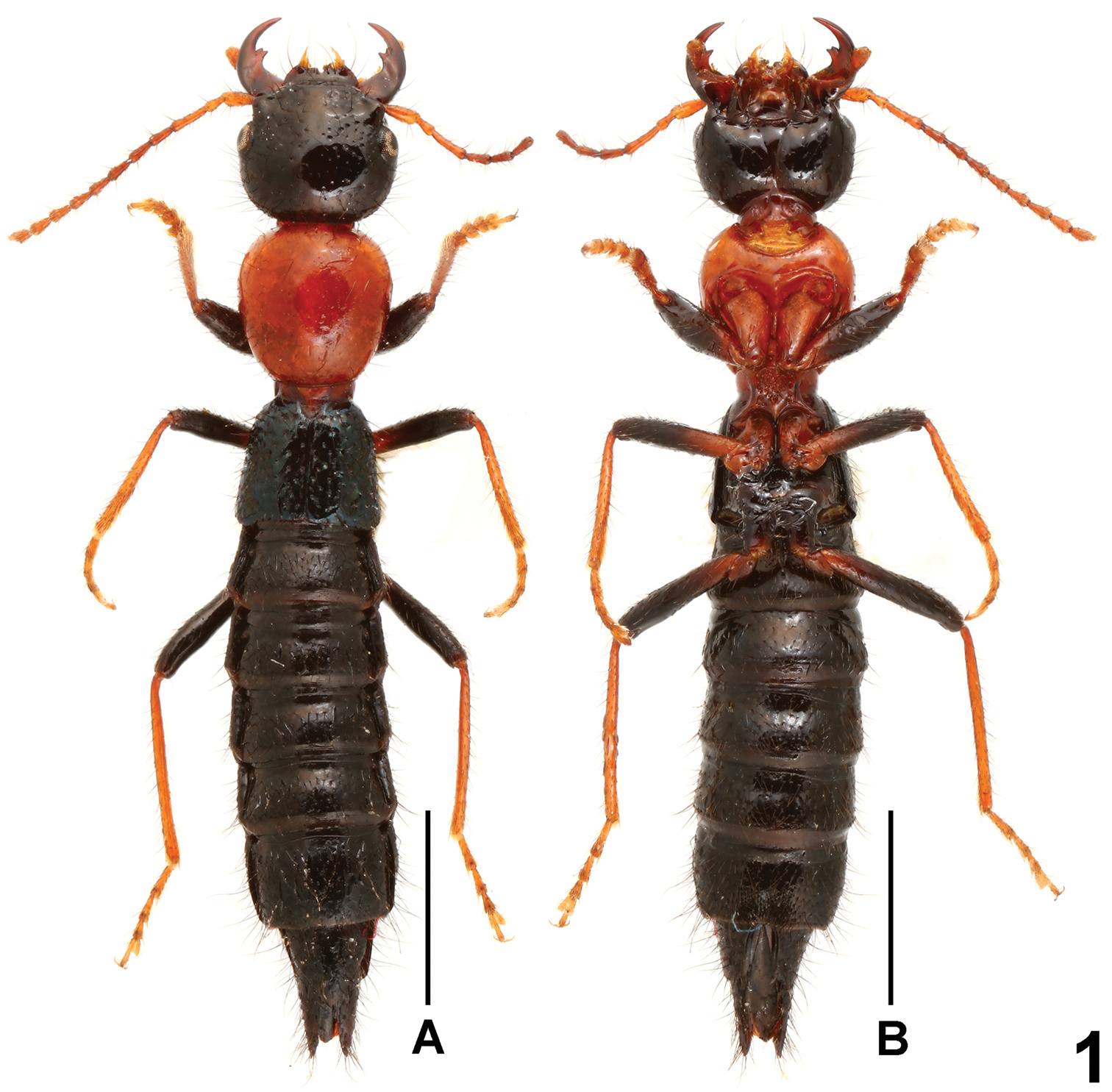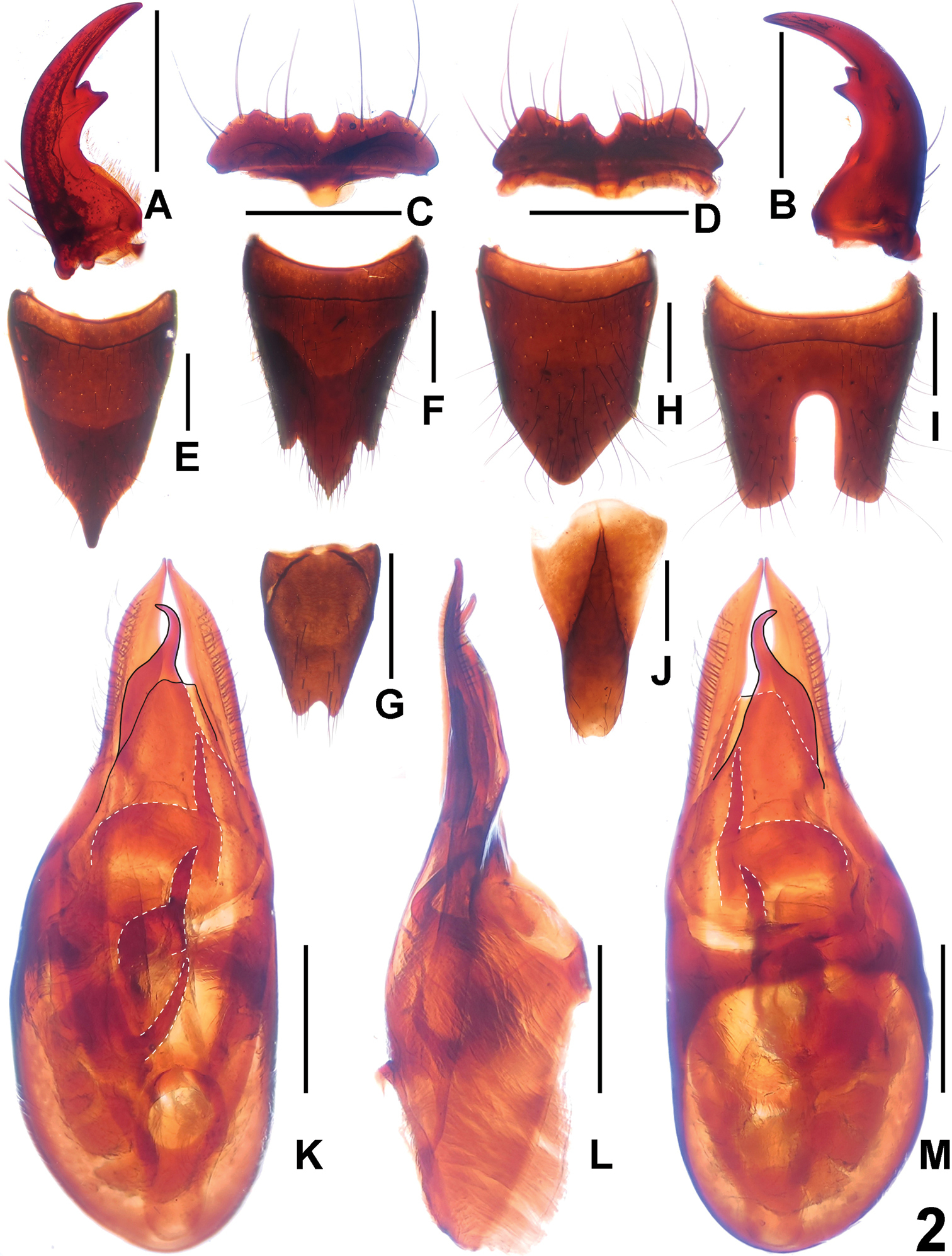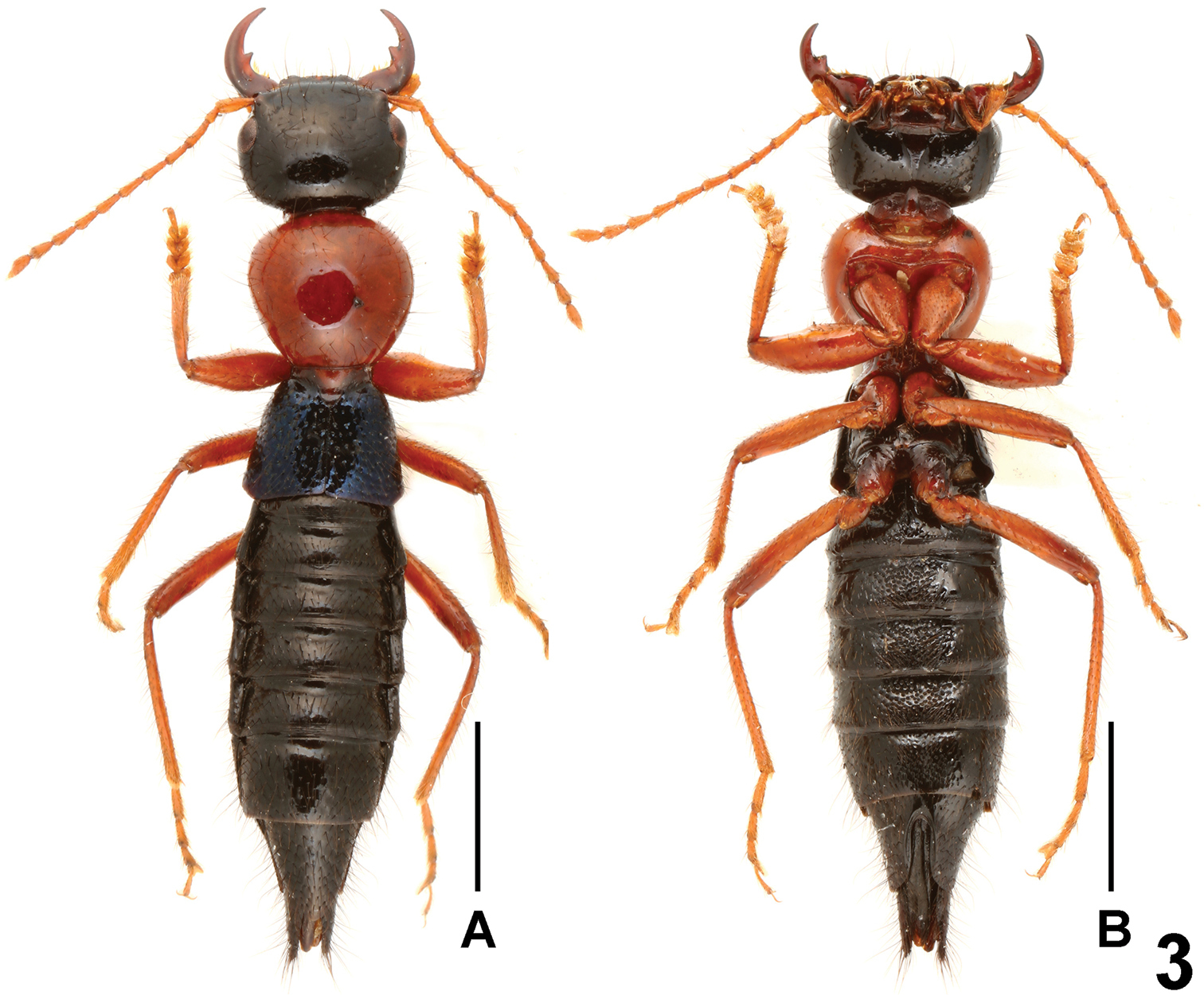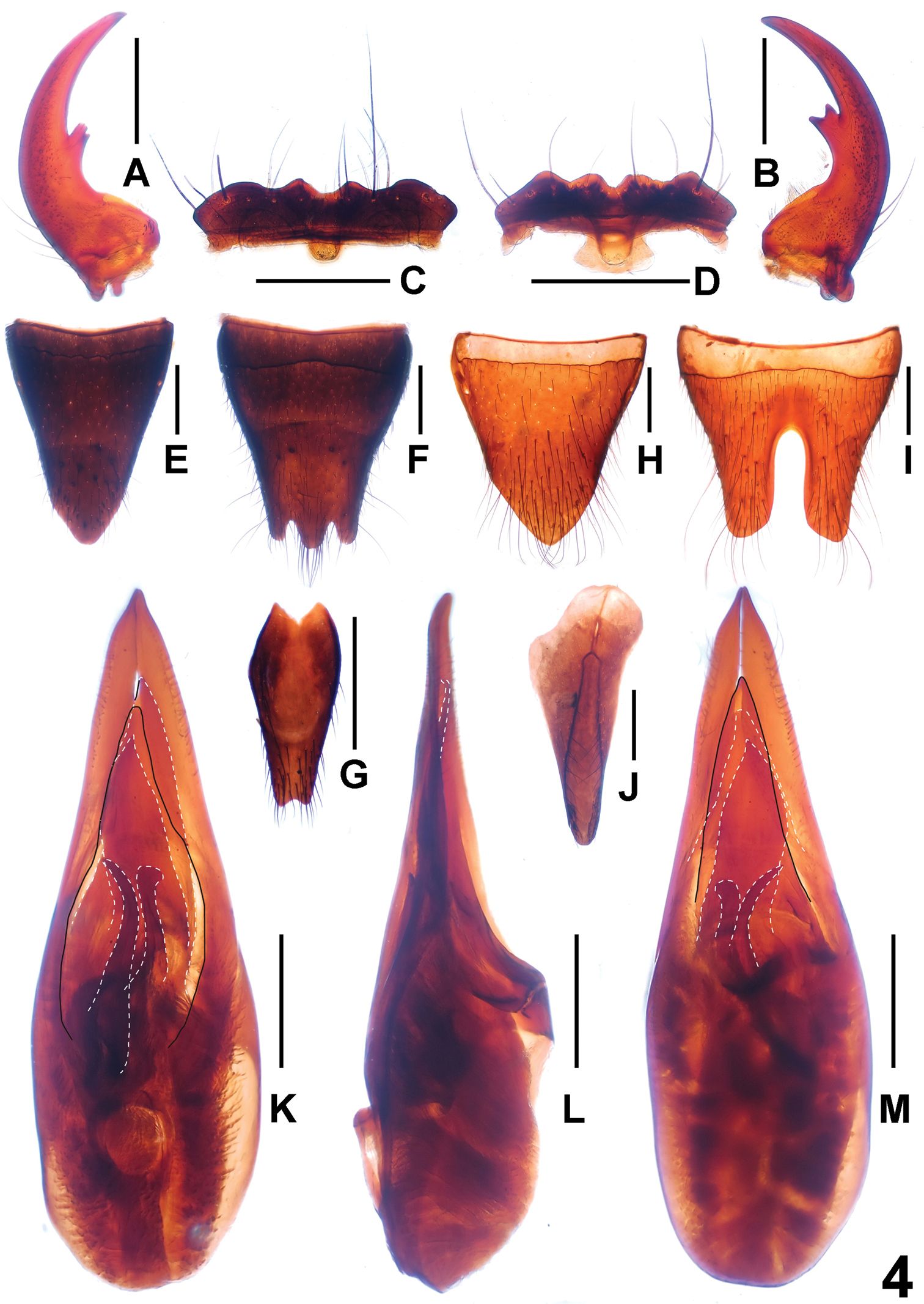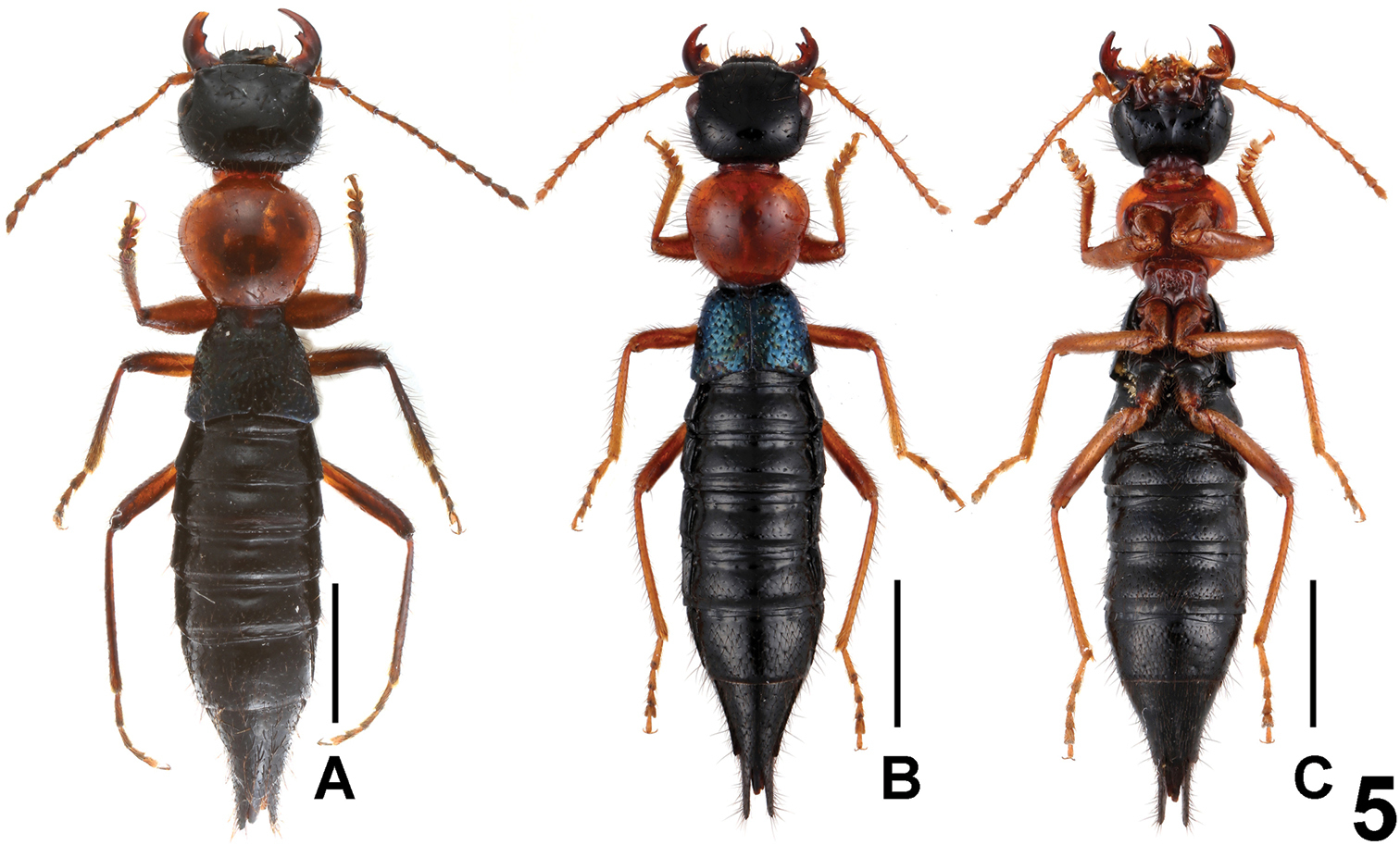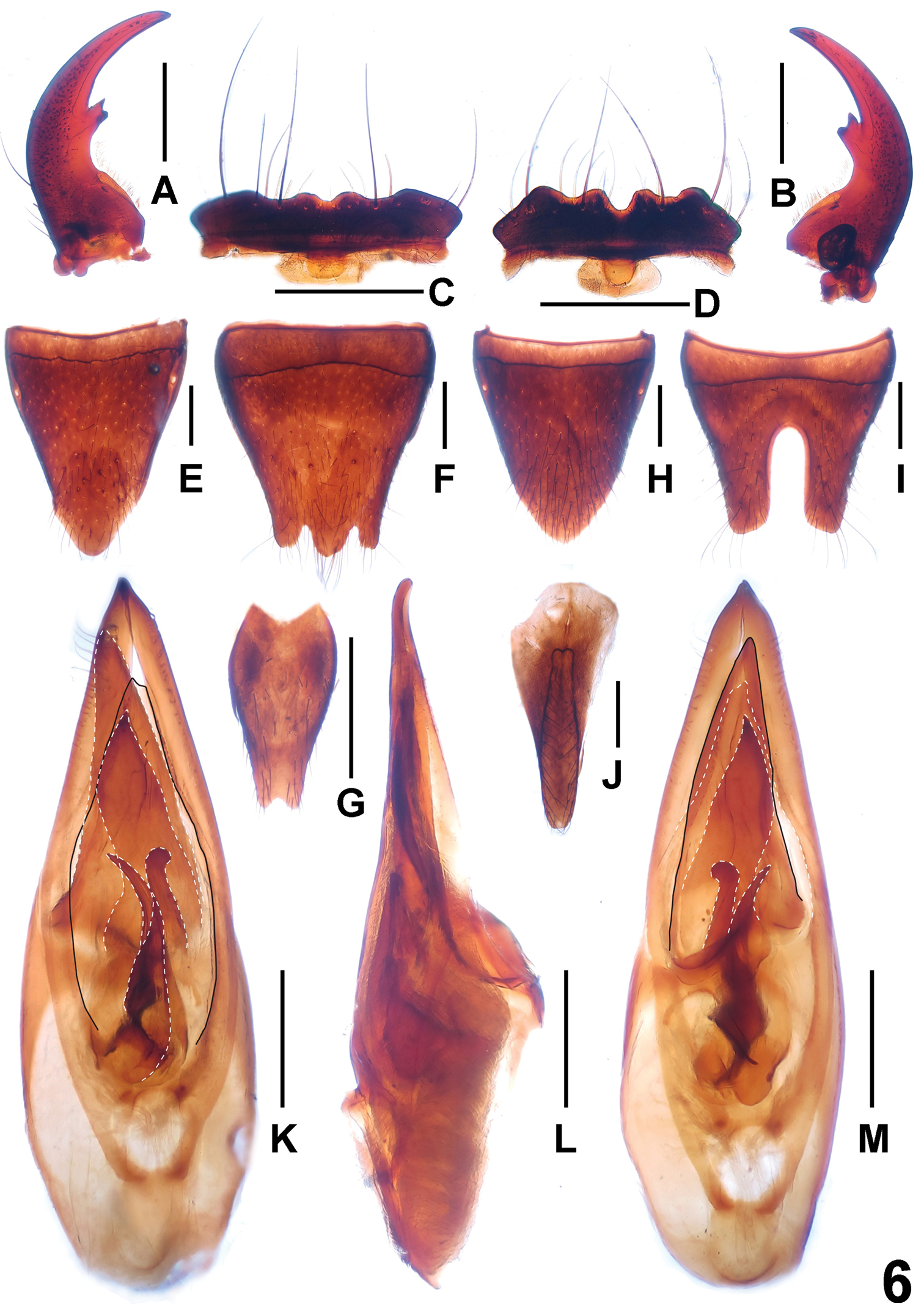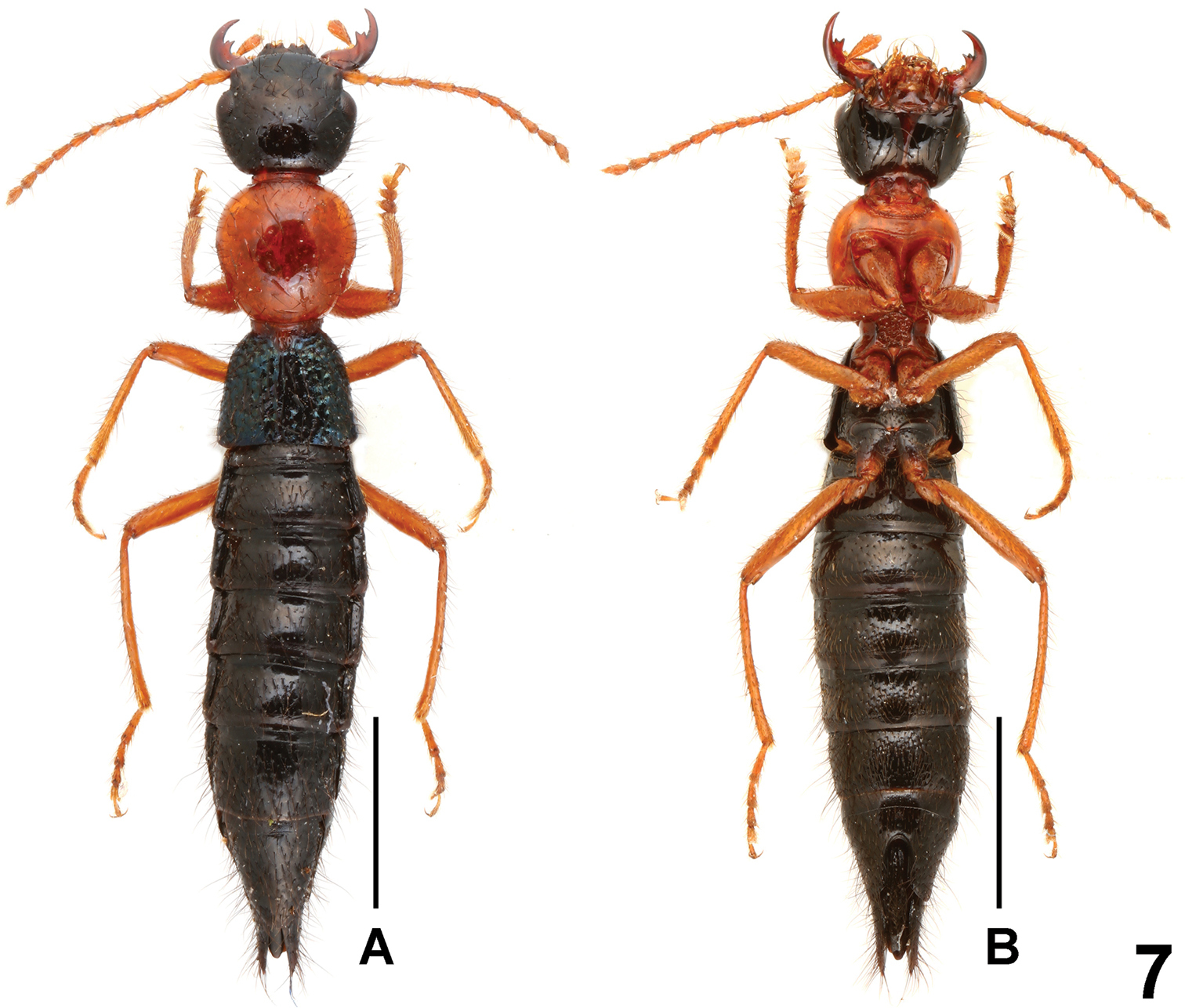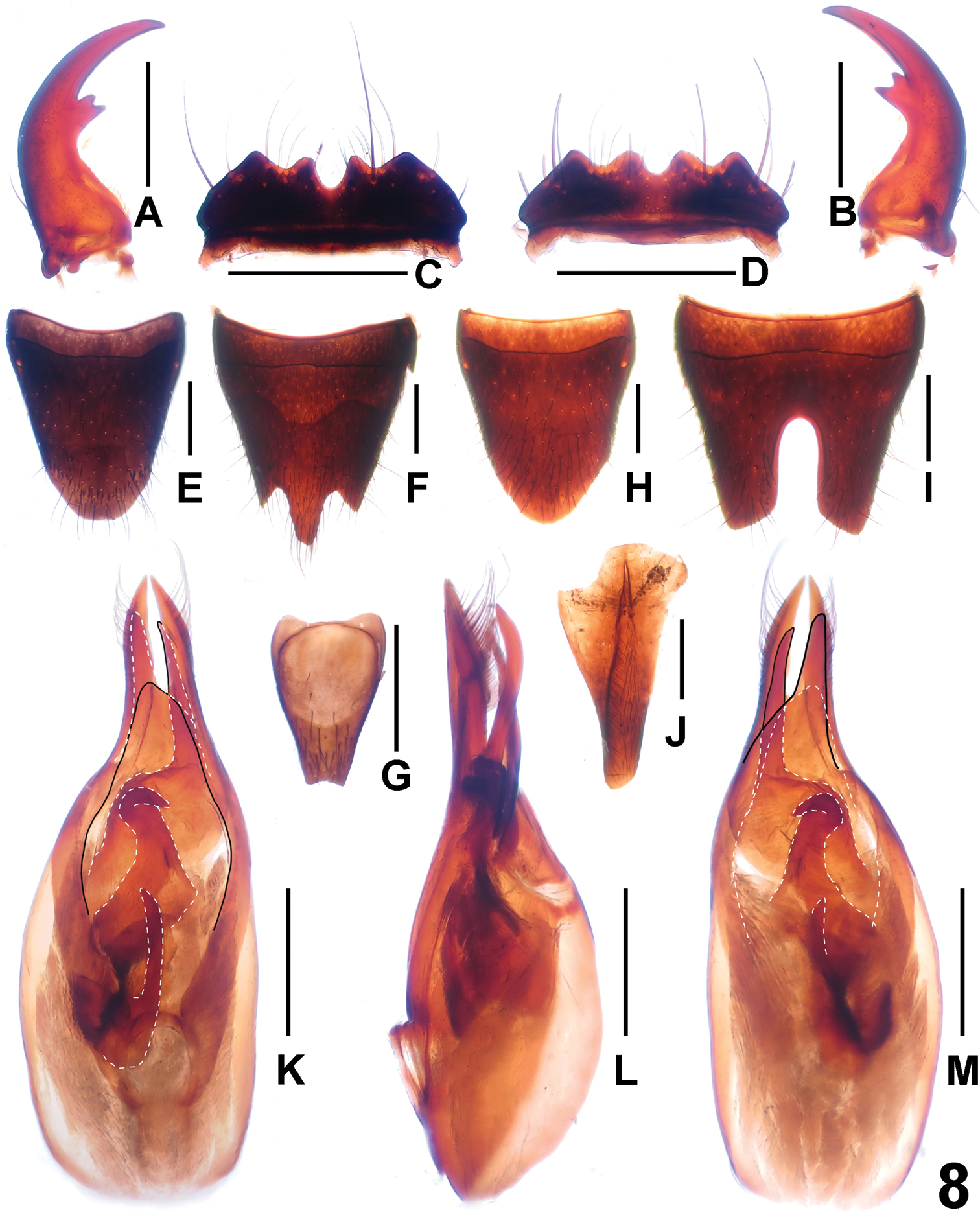






Citation: Peng Z, Li L-Z, Zhao M-J (2014) New data on the Paederus biacutus species group from mainland China (Coleoptera, Staphylinidae, Paederinae). ZooKeys 419: 117–128. doi: 10.3897/zookeys.419.7764
Paederus jianyueae Peng & Li, sp. n. (Zhejiang: Qingliangfeng) is described and illustrated. Additional records of P. biacutus Li, Zhou & Solodovnikov, 2014 and P. parvidenticulatus Li, Zhou & Solodovnikov, 2014 are reported.
Coleoptera, Staphylinidae, Paederus, new species, new records, mainland China
The Paederus fauna of China previously comprised 36 species, some of which were assigned to subgenera and some are listed as incertae sedis (
A study of Paederus material from mainland China yielded some new records and a new species of the Paederus biacutus group.
The morphological studies were conducted using an Olympus CX31 microscope. The images were prepared using a Canon EOS 70D (with an MP-E 65 macrolens) and Canon G12 camera. The line drawings were created using Adobe Illustrator CS3 software.
The following abbreviations are used in the text, with all measurements in millimeters:
Body length (BL): length of body from the anterior margin of the labrum to the apex of the abdomen.
Forebody length (FL): length of forebody from the anterior margin of the labrum to the posterior margin of elytra at suture.
Head length (HL): length of head from the anterior clypeal margin to the occipital constriction.
Head width (HW): maximum width of head (including eyes).
Antenna length (AnL): length of antennae from base of antennomere I to apex of antennomere XI.
Pronotum length (PL): length of pronotum along midline.
Pronotum width (PW): maximum width of pronotum.
Elytral length (EL): at the suture from the apex of the scutellum to the posterior margin of the elytra (at the sutural angle).
Elytral width (EW): maximum width of elytra.
Abdominal width (AW): maximum width of abdomen.
Aedeagus length (AL): length of the aedeagus from the apices of the parameres to the base of the aedeagal capsule.
The labels are cited in the original spelling. The type material is deposited in the Insect Collection of Shanghai Normal University, Shanghai, China (SNUC).
(8 ♂♂, 2 ♀♀). 1 ♂, 1 ♀, “China: Fujian Prov., Wuyishan, Guadun, 27°44'N, 117°38'E, 02.vi.2012 1, 300 m, Peng & Dai leg.” (SNUC); 1 ♂, “China: Fujian Prov., Wuyishan, Guadun, Xianfengling, 27°42'N, 117°39'E, 08.iv.2013 1, 200 m, Wen-Xuan Bi leg.” (SNUC); 1 ♂, “China: Fujian Prov., Wuyishan, Sangang, 27°44'59"N, 117°40'47"E, 02.vii.? 750 m, Da-Kang Zhou leg.” (SNUC); 2 ♂♂, “China: Fujian Prov., Wuyishan, Guadun, 27°44'02"N, 117°38'26"E, 30.viii.2009 1, 200 m, Hao Huang leg.” (SNUC); 3 ♂♂, 1 ♀, “China: Jiangxi Prov., Yanshan County, Wuyi Shan, 27°55'45"N, 117°40'43"E, 10.v.2005 alt. 950 m, Hu & Tang leg.” (SNUC).
A comparison of the original description of Paederus biacutus and the additional material from the type locality and its vicinity revealed some differences in the sexual characters. According to the original description and illustration, the female sternite VIII is transverse (oblong in the additional material, Fig. 2F) and the internal sac of the aedeagus has two sclerotized spines (three spines in the additional material, Fig. 2K). The previously known distribution of Paederus biacutus included the Chinese province of Fujian (
Habitus of Paederus biacutus. A lateral view B ventral view. Scales: 2.0 mm.
Paederus biacutus. A male left mandible B male right mandible C male labrum D female labrum E female tergite VIII F female sternite VIII G female sternite IX H male tergite VIII I male sternite VIII J male tergite IX K aedeagus in ventral view L aedeagus in lateral view M aedeagus in dorsal view. Scales: 0.5 mm.
(16 ♂♂, 21 ♀♀). 1 ♂, “China: Guangxi Prov., Xing’an, Maoer Shan, 25°52'23"N, 110°25'06"E, 23.vii.2012 1950–2000 m, Hu & Song leg.” (SNUC); 1 ♂, 4 ♀♀, “China: Guangxi Prov., Xing’an, Maoer Shan, 25°54'23"N, 110°27'41"E, 24.vii.2012 1550–1750 m, Hu & Song leg.” (SNUC); 4 ♂♂, 14 ♀♀, “China: Guangxi Prov., Xing’an, Maoer Shan, 25°52'18"N, 110°25'01"E, 10.vii.2011 1900–2100 m, He, Tang & Peng leg.” (SNUC); 7 ♂♂, 1 ♀, “China: Guangxi Prov., Xing’an, Maoer Shan, 25°54'17"N, 110°28'04"E, 02.vi.2012 1100–1700 m, Liu & Living leg.” (SNUC); 1 ♂, 1 ♀, “China: Guizhou Prov., Leishan County, Leigong Shan, 26°22'38"N, 108°11'47"E, 06.vi.2012 1500–1600 m, Liu & Living.” (SNUC); 2 ♂♂, 1 ♀, “China: Guizhou Prov., Leigong Shan, Lianhuaping, 15.ix.2005 1450–1500 m, Li-Long Zhu leg.” (SNUC).
An examination of the above material from the type localities of Paederus symmetricus and Paederus parvidenticulatus revealed that they are conspecific. A paper formally proposing the respective synonymy is being prepared by Xiao-Yan Li (pers. comm.).
Habitus of Paederus parvidenticulatus (Leigong Shan). A lateral view B ventral view. Scales: 2.0 mm.
Paederus parvidenticulatus (Leigong Shan). A male left mandible B male right mandible C male labrum D female labrum E female tergite VIII F female sternite VIII G female sternite IX H male tergite VIII I male sternite VIII J male tergite IX K aedeagus in ventral view L aedeagus in lateral view M aedeagus in dorsal view. Scales: 0.5 mm.
Habitus of Paederus parvidenticulatus (Maoer Shan). A–B lateral view C ventral view. Scales: 2.0 mm.
http://zoobank.org/49639086-9045-438B-8153-21D951D84CAC
Figs 7–8(14 ♂♂, 28 ♀♀). Holotype: ♂, labelled ‘China: Zhejiang Prov., Lin’an, Qingliangfeng, 30°05'48"N, 118°51'36"E, alt. 1500–1700 m 22.v.2012, Yi & Zhang leg.’ (SNUC). Paratypes: 12 ♂♂, 28 ♀♀, same label data as holotype (SNUC); 1 ♂, same data, but ‘Anhui Prov. Huang Shan, 30°07'51"N, 118°09'51"E, 18.v.2005 alt. 1700 m, Wen-Xuan Bi leg.’ (SNUC).
Measurements (in mm) and ratios: BL 9.23–10.34, FL 4.56–4.78, HL 1.30–1.41, HW 1.52–1.61, AnL 2.78–2.95, PL 1.59–1.67, PW 1.54–1.66, EL 1.02–1.13, EW 1.52–1.61, AW 1.70–1.85, AL 1.04–1.09, HL/HW 0.85–0.89, HW/PW 0.95–0.98, HL/PL 0.81–0.85, PL/PW 0.98–1.03, EL/PL 0.64–0.68, diameter of eye: 0.37–0.44.
Habitus as in Fig. 7. Coloration: head, pronotum and abdomen black; elytra black with faint blueish hue; legs and antennae dark-yellowish, apices of femora and tibiae not infuscate.
Paederus parvidenticulatus (Maoer Shan). A male left mandible B male right mandible C male labrum D female labrum E female tergite VIII F female sternite VIII G female sternite IX H male tergite VIII I male sternite VIII J male tergite IX K aedeagus in ventral view L aedeagus in lateral view M aedeagus in dorsal view. Scales: 0.5 mm.
Head transverse; shape without apparent sexual dimorphism; widest across eyes; punctation moderately coarse and very sparse; interstices glossy. Eyes distinctly convex, 0.6–0.8 times as long as postocular region in dorsal view. All antennomeres oblong.
Pronotum nearly globulous, strongly convex in cross-section; punctation similar to that of head, very sparse.
Elytra trapeziform; punctation coarse, moderately defined, and dense. Hind wings completely reduced. Metatarsomere I as long as combined length of metatarsomeres II and III.
Abdomen distinctly broader than elytra; punctation sparse; interstices with shallow microsculpture; posterior margin of tergite VII without palisade fringe; posterior margin of tergite VIII (Fig. 8E, H) strongly convex.
Habitus of Paederus jianyueae. A lateral view B ventral view. Scales: 2.0 mm.
Male. Labrum (Fig. 8C) distinctly sinuate, anterior margin with two pairs of obtuse teeth; mandibles (Fig. 8A–B) long and robust, inner margin with one bicuspidate tooth. Sternite VII unmodified; sternite VIII (Fig. 8I) weakly transverse and with deep and narrow posterior incision, this incision approximately 0.4 times as long as sternite VIII; sternite IX (Fig. 8J) asymmetric; aedeagus as in Fig. 8K–M; dorsal plate of median lobe asymmetric, curved in lateral view and not reaching apices of parameres, its base broad and narrowed posteriad; parameres symmetric and slender; internal sac with three distinctive sclerotized spines.
Female. Labrum as in Fig. 8D. Posterior margin of sternite VIII symmetric and trifurcate as in Fig. 8F; sternite IX (Fig. 8G) symmetrical and stout.
Paederus jianyueae. A male left mandible B male right mandible C male labrum D female labrum E female tergite VIII F female sternite VIII G female sternite IX H male tergite VIII I male sternite VIII J male tergites IX K aedeagus in ventral view L aedeagus in lateral view M aedeagus in dorsal view. Scales: 0.5 mm.
The species was found in two geographically close localities: Qingliangfeng, western Zhejiang and the Huang Shan, southeastern Anhui. The specimens were sifted from leaf litter and moss in coniferous forests at altitudes of 1500–1700 m.
The species is named after Jian-Yue Qiu, who lent extensive support to our research.
Paederus jianyueae belongs to the Paederus biacutus group, as can be inferred both from the sexual characters and from the external morphology (special color pattern, four protrusions on anterior margin of labrum, morphology of the aedeagus, shape of the male sternite IX and the female sternite VIII). This new species is distinguished from other species of this group by the shape of female sternite VIII and the morphology of the aedeagus (more slender dorsal plate of the median lobe; slender parameres; three distinctive sclerotized spines in the internal sac). Based on the similar morphology of the aedeagus, Paederus jianyueae may be most closely related to Paederus biacutus Li, Zhou & Solodovnikov, 2013.
All the collectors mentioned in the text are acknowledged for their field work. Two anonymous reviewers are thanked for comments on a previous version of the manuscript. Special thanks are extended to Volker Assing (Hannover, Germany) for his comments on an earlier version of the manuscript. We would like to thank Tie-Xiong Zhao (Zhejiang, China) for the generous gift of specimens. We are most grateful to Jian-Yue Qiu (Chongqing, China) for her extensive support during our work. We thank Xiao-Yan Li (Beijing, China) for helpful discussions. The study is supported by the National Natural Science Foundation of China (No. 31101659 and No. 31172134, 31201734), the Foundation of Shanghai Municipal Education Commission (No. 12YZ077 and No. 13YZ062) and Shanghai Normal University (SK201234, DZL125 and B–9013–11–003127).
